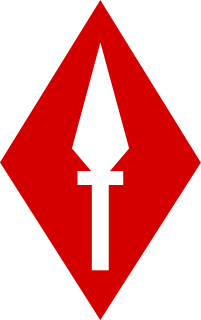
I Corps was an army corps in existence as an active formation in the British Army for most of the 80 years from its creation in the First World War until the end of the Cold War, longer than any other corps. It had a short-lived precursor during the Waterloo Campaign.

The Battle of Saint-Mihiel was a major World War I battle fought from 12–15 September 1918, involving the American Expeditionary Forces (AEF) and 110,000 French troops under the command of General John J. Pershing of the United States against German positions. The U.S. Army Air Service played a significant role in this action.

The 84th Training Command ("Railsplitters") is a formation of the United States Army. During World War I and World War II, it was known as the 84th Infantry Division. From 1946 to 1952, the division was a part of the United States Army Reserve as the 84th Airborne Division. In 1959, the division was reorganized and redesignated once more to the 84th Division. The division was headquartered in Milwaukee in command of over 4,100 soldiers divided into eight brigades—including an ROTC brigade—spread throughout seven states.

The 80th Training Command is a formation of the United States Army Reserve. During World War I and World War II, the unit was designated the 80th Infantry Division. Nicknamed the "Blue Ridge Division", it was initially composed of draftees from the mid-atlantic states of Virginia, West Virginia, Pennsylvania and Maryland.

The 81st Infantry Division ("Wildcat") was originally organized as a National Army division in 1917 for service during World War I. After World War I, the 81st Division was allotted to the Organized Reserve as a "skeletonized" cadre division. In 1942, the division was reactivated and reorganized as the 81st Infantry Division, and service in the Pacific during World War II. After World War II, the 81st Infantry Division was allotted to the Organized Reserve as a Class C cadre division, and stationed at Atlanta Georgia. The 81st Infantry Division saw no active service during the Cold War, and was inactivated in 1965. In 1967 the division's shoulder sleeve insignia was reactivated for use by the 81st Army Reserve Command . From 1967 to 1995, the 81st ARCOM commanded and controlled Army Reserve units in Georgia, South Carolina, Puerto Rico and portions of North Carolina, Florida and Alabama. During that time, the 81st ARCOM was responsible for deploying US Army Reserve units to Vietnam, Southwest Asia, and the Balkans. The 81st was relocated in 1996 to Birmingham, Alabama and reorganized as the 81st Regional Support Command (RSC) and was responsible command and control of all Army Reserve units in the southeast United States and Puerto Rico. In 2003, the 81st RSC was reorganized as the 81st Regional Readiness Command (RRC), but retained essentially the same mission as its predecessor. In September 2008, the 81st RRC inactivated at Birmingham, Alabama. In its place, a reorganized 81st Regional Support Command (RSC) was activated at Fort Jackson, South Carolina. Unlike its predecessor units, the new 81st RSC had a fundamentally different mission. Gone was the responsibility for hundreds of Troop Program Units (TPU) units and Soldiers. Instead, the 81st RSC provided Base Operations (BASOPS) support to 497 Army Reserve units in nine southeastern states plus Puerto Rico and the US Virgin Islands. By providing the essential customer care and services, the 81st RSC was intended to help the supported Operational, Functional and Training (OF&T) commands to focus on their core unit mission and ultimately meet force requirements for global combatant commanders. In 2018, the 81st RSC was provisionally redesignated as the 81st Readiness Division, and designated to gain additional responsibilities from other Army Reserve Functional Commands in addition to the enduring BASOPS mission. On 1 October 2018, the 81st RSC was officially reorganized as the 81st Readiness Division (USAR).

The 86th Infantry Division was a unit of the United States Army in World War I and World War II. Currently called the 86th Training Division, based at Fort McCoy, Wisconsin, members of the division now work with Active Army, Reserve, and National Guard units to provide them with a Decisive Action Training Environment on a yearly basis.

The 76th Infantry Division was a unit of the United States Army in World War I, World War II and the Cold War. The division was inactivated in 1996 and has been reconstituted as the 76th US Army Reserve Operational Response Command in 2013.
The units listed to participate in Operation Downfall—the planned Allied invasion of Japan— in August 1945 were:

The Second Battle of Guam was the American recapture of the Japanese-held island of Guam, a U.S. territory in the Mariana Islands captured by the Japanese from the U.S. in the 1941 First Battle of Guam during the Pacific campaign of World War II.
The V Corps was a unit of the Union Army of the Potomac during the American Civil War.

The VI Corps was a corps of the Union Army during the American Civil War.
The XVI Army Corps was a corps of the Union Army during the American Civil War. The corps rarely fought as one unified unit, as its divisions were often scattered across the country.

Elon John Farnsworth was a Union Army cavalry general in the American Civil War, killed at the Battle of Gettysburg.

William Hays was a career officer in the United States Army, serving as a Union Army general during the American Civil War.

The Malaya Command was a formation of the British Army formed in the 1920s for the coordination of the defences of British Malaya, which comprised the Straits Settlements, the Federated Malay States and the Unfederated Malay States. It consisted mainly of small garrison forces in Kuala Lumpur, Penang, Taiping, Seremban and Singapore.
This is the order of battle of German and Allied forces during the Battle of the Bulge — specifically, at a point near the end of the battle, which lasted from 16 December 1944 until 25 January 1945.
The 7th (Meerut) Division was an infantry division of the British Indian Army that saw active service during World War I.
The 3rd (Lahore) Division was an infantry division of the British Indian Army, first organised in 1852. It saw service during World War I as part of the Indian Corps in France before being moved to the Middle East where it fought against troops of the Ottoman Empire.
The Indian Army had no standby force ready in 1971 with the specific task of attacking West Pakistan, one of the many reasons why India did not immediately intervene after Pakistan launched Operation Searchlight in March 1971. Indian Army Eastern Command was tasked with defending the northern and eastern borders and fighting the insurgencies in Nagaland, Mizoram and Naxalites in West Bengal at that time. Mukti Bahini, aided by the Indian army through Operation Jackpot, led the struggle against the Pakistan army while the Indian army readied for intervention. General M. A. G. Osmani, Commander in Chief Bangladesh Forces, had divided Mukti Bahini forces into 11 geographical sectors for command and control purpose. Mukti Bahini forces numbered 30,000 regular soldiers and at least 100,000 guerrillas by December 1971. The Indian Army Eastern Command assembled two existing infantry corps, the IVth and the XXXIIIrd, for operations in Bangladesh, and created a new corps (II) besides reorganising the 101st Communication Zone as a combat formation. On 21 November 1971, Indian and Bangladesh forces were put under a joint command structure, led by Lt. Gen. Jagjit Singh Aurora, and this force came to be known as Mitro Bahini. In addition to 29 BSF battalions, Mukti Bahini guerrillas operating near the border or awaiting deployment in camps inside India were organised into infantry companies and attached to various Indian formations.

Adelbert Cronkhite was a career officer in the United States Army. He was notable for his command of the 80th Division during World War I. He also served as interim commander of IX Corps and commander of VI Corps after the war. In addition, his later command assignments included the Newport News Port of Debarkation, the Coast Artillery Training Center, and Third Corps Area.




























